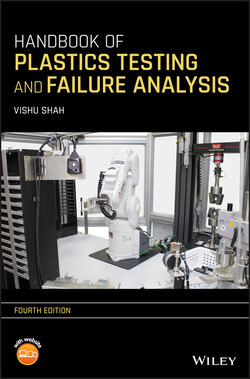Читать книгу Handbook of Plastics Testing and Failure Analysis - Vishu Shah - Страница 12
PREFACE TO THE FIRST EDITION
ОглавлениеThe desire to compile this book was initiated mainly because of the virtual non‐existence of a comprehensive work on testing of plastic materials. The majority of the literature concerning the testing of plastics is scattered in the form of sales and technical brochures, private organizations’ internal test procedures, or a very brief and oversimplified explanation of the test procedures in plastics literature. The main objective of the present book is to provide a general purpose practical text on the subject with the main emphasis on the significance of the test or why and not so much on how without being extremely technical.
Over the years ASTM (American Society for Testing and Materials) has done an excellent job in providing the industry with standard testing procedures. However, the test procedures discussed in ASTM books lack the theoretical aspects of testing. The full emphasis is not on significance of testing but on procedures of testing. The ASTM books are also deficient in showing the diagrams and photographs of actual, commercial testing equipment. In this book I have tried to bridge the gap between the oversimplified and less explained tests described in ASTM books and the highly technical and less practical books in existence today.
This handbook is not intended primarily for specialists and experts in the area of plastics testing but for the neophyte desiring to acquire a basic knowledge of the testing of plastics. It is for this reason that detailed discussions and excessive technical jargon have been avoided. The text is aimed at anyone involved in manufacturing, testing, studying, or developing plastics. It is my intention to appeal to a broad segment of people involved in the plastic industry.
In Chapter 1 the basic concepts of testing are discussed along with the purpose of specifications and standards. Also discussed is the basic specification format and classification system. The subsequent chapters deal with the testing of five basic properties: mechanical, thermal, electrical, weathering, and optical properties of plastics. The chapter on mechanical properties discusses in detail the basic stress–strain behavior of the plastic materials so that a clear understanding of testing procedures is obtained. Chapter 7 on material characterization is intended to present a general overview of the latest in characterization techniques in existence today. A brief explanation of the polymer combustion process along with various testing procedures are discussed in Chapter 8. An attempt is made to briefly explain the importance of conditioning procedures. A table summarizing the most common conditioning procedures should be valuable. Several tests that are difficult to incorporate into a specific category were placed in the chapter on miscellaneous tests. End‐product testing, an area generally neglected by the majority of processors of plastic products, is discussed along with some useful suggestions on common end‐product tests.
Chapter 13 on identification analysis should be important to everyone involved in plastics and particularly useful to plastic converters and reprocessors. The flowchart summarizes the entire identification technique. Since there are so many different tests in existence on the testing of foam plastics, only a brief explanation of each test is given. The chapter on failure analysis is a compilation of methods commonly used by material suppliers. A step‐by‐step procedure for analyzing product failure should prove valuable to anyone ivolved in failure analysis. Quality control, although not part of the testing, is included in order to explain quality control as it relates to plastics. The section on visual standard, mold control, and workmanship standard is a good example. In this increasing world of product liability, the chapter on product liability and testing should be of value to everyone.
In order to increase the versatility of this book and meet the goal of providing a ready reference on the subject of testing, a large appendix section is given. One will find very useful data: names and addresses of equipment manufacturers, a glossary, names and addresses of trade publications, information on independent testing laboratories, and a guide to plastics specifications. Many useful charts and tables are included in the appendix. Throughout the book, wherever possible, numerous diagrams, sketches, and actual photographs of equipment are given.
A handbook of this magnitude must make inevitable compromises. Depending on the need of the individual user, there is bound to be a varying degree of excess and shortage. In spite of every effort made to minimize mistakes and other short‐comings in this book, some may still exist. For the sake of future refinement and improvements, all constructive comments will be welcomed and greatly appreciated.
Vishu Shah
Pomona, CaliforniaOctober 1983
